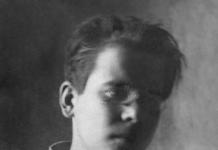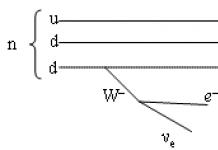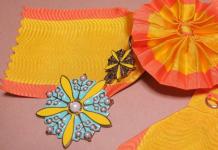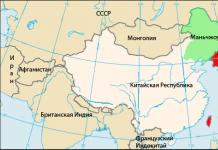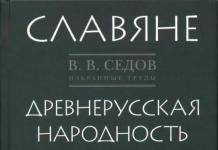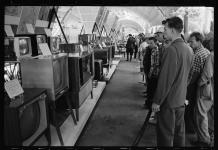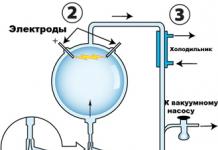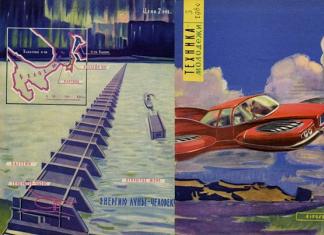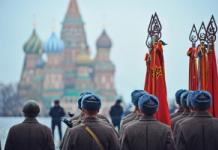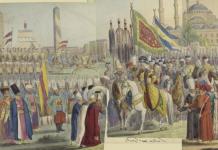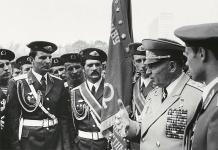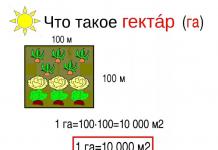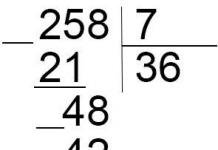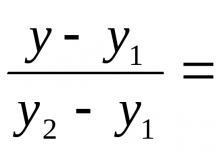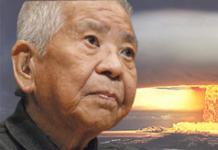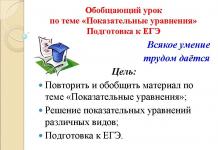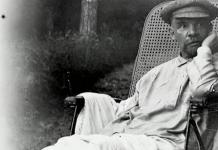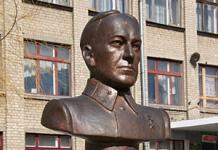In 1755, Bazhenov entered Moscow University, in 1756 he transferred to a gymnasium at the St. Petersburg Academy of Sciences, was a student of Savva Chevakinsky, and at the same time participated in his architectural work.
In 1758-1760 he studied at the St. Petersburg Academy of Arts with architects Alexander Kokorinov and Jean-Baptiste-Michel Wallen-Delamotte. Upon completion of the course, I received a pension (maintenance) to continue my studies abroad.
In 1760-1762 he studied at the Paris Academy of Arts under the famous architect Charles de Vailly.
The project of the House of Invalids, carried out by Bazhenov in Paris, was approved by the Royal Academy of Architecture. Petersburg Academy of Arts, where the drawings were sent, in 1762 awarded him the title of adjunct, assistant professor.
In the fall of 1762, Bazhenov was transferred to Rome, where he studied the monuments of classical antiquity and the Renaissance, mastered the construction practice of Italian masters. He was elected a member of the Academy of St. Luke, from which he received a diploma and the privilege "to be a master and professor of architecture, both in Rome and elsewhere"; accepted as a member of the Academy of Drawing in Florence and Clementine in Bologna.
Not receiving funds from St. Petersburg and in great need of money, he was forced to return to Paris in 1764 and for more than six months to sell his personal belongings.
Upon his return to St. Petersburg in 1765, Bazhenov passed the exam and received the title of academician of architecture, but did not become a professor, having received an appointment as an architect of the artillery department with the rank of captain.
In this position, the architect built an arsenal building in St. Petersburg on Liteynaya Street (now the building of judicial institutions).
During a business trip to Moscow, Bazhenov was awarded an audience with Empress Catherine II, after which he was entrusted with the project of rebuilding the Moscow Kremlin and the construction of a palace on its territory. The project developed by the architect provided for the reconstruction of the entire Kremlin ensemble and Red Square. The main building of the palace was supposed to bend around the Kremlin hill from the side of the Moskva River, for which part of the Kremlin wall with towers was dismantled. The center of the composition was supposed to be an oval square with colonnades and an amphitheater for spectators; the main radial streets of the center of Moscow converged to it. The powerful basement of the palace and the high colonnade were supposed to hide the ancient buildings of Cathedral Square. In 1773, the foundation stone of the palace took place, and in 1775 the project was stopped. Drawings and a wooden model have been preserved from the grandiose plan, which is presented in the State Museum of Architecture named after A.V. Shchusev in Moscow.
The destroyed walls of the Kremlin were restored, the reconstruction of the ensemble was transferred to Matvey Kazakov.
After the celebrations designed by Bazhenov on the occasion of the conclusion of the Kuchuk-Kainardzhiyskiy peace with Turkey on the Khodynskoye field in Moscow (1774-1775; known from Kazakov's drawings), Catherine II commissioned the architect to create a new residence near Moscow in Tsaritsyn. The palace and park ensemble, which was built in 1775-1785, organically included a hilly landscape, ponds and buildings, freely located at different levels. However, this ensemble was not completed - the empress did not like it, who ordered the palaces and main buildings to be destroyed.
Of the 17 buildings of the palace complex, three small pavilions have survived, later called the First, Second and Third Cavalry Buildings.
The likely reason for Catherine II's anger was Bazhenov's closeness to the heir to the throne, the future Emperor Paul I, and to the Moscow masons. Bazhenov became acquainted with Freemasonry while still in Europe, in Moscow he became close to the circle of Nikolai Novikov and became a member of the lodge. The Empress became aware of the transfer of the Masonic books to the heir from Novikov through Bazhenov. The architect was removed from construction and dismissed from public service.
Bazhenov managed to partially implement his urban planning ideas in the Pashkov house in Moscow (1784-1786).
Among other Moscow buildings of Bazhenov - Dolgov's house on 1st Meshchanskaya street (now - Prospect Mira, 1770); the bell tower and refectory of the Church of All Who Sorrow on Bolshaya Ordynka Street and Yushkov's House on Myasnitskaya Street (1780s).
In 1782-1789, Bazhenov built a manor church in the village of Bykovo near Moscow.
Since 1792, Bazhenov lived in St. Petersburg, participated in the construction of Gatchina and Pavlovsk, designed the Mikhailovsky Castle (1792-1796).
In 1796, after the accession to the throne of Paul I, Bazhenov became a full state councilor, and in 1799 - vice-president of the Academy of Arts.
Due to illness, Bazhenov was unable to lead the construction of the Mikhailovsky Castle, which in 1797-1800 was erected by Viktor Brenna, who retained Bazhenov's plan, but made his own changes to the project, and Yegor Sokolov.
Bazhenov was the first Russian architect to create his projects as volumetric-spatial compositions associated with the landscape and organizing the environment. In the Moscow period, he created an architectural team and a school for the Expedition of the Kremlin building, where architects Matvey Kazakov, Karl Blank, Ivan Egotov, Elizvoy Nazarov worked.
The Russian translation of Vitruvius was published under the editorship of Bazhenov.
On August 13 (August 2, old style), 1799 Vasily Bazhenov died in St. Petersburg. He was buried on his estate in the village of Staraye Glazovo, Kashirsky district, Tula province (now Venevsky district, Tula region).
Vasily Bazhenov since 1768 was married to Agrafena Dolgova. Four sons were born in the family of the architect: Konstantin, who became a major general; Vladimir - major general, architect, father's assistant in all works of recent years; Vsevolod - Colonel, Commander of the Pioneer Team of the Admiralty Collegium; Warrior (1779-1784). The architect also had three daughters: Olga (married to Gette), Vera and Nadezhda (married to Markov).
The material was prepared on the basis of information from open sources
The famous Russian artist-architect, theorist of architecture, academician (1765) and vice-president of the St. Petersburg Academy of Arts (1799), one of the founders of classicism. He did a lot to preserve the architectural appearance of Moscow as the author of projects for the reconstruction of the Moscow Kremlin (1767 - 1775), the Tsaritsyno imperial estate near Moscow (1775 - 1785), the house of the nobleman Pashkov (1784 - 1786), the Yushkov house on Myasnitskaya Street ( late 1780s), churches in the village. Bykovo near Moscow (1782 - 1789) and others (born in 1737 or 1738 - died in 1799)
Bazhenov is undoubtedly one of the brightest Russian architects thanks to the scope of his ideas, freedom, strength and originality of creative imagination. Despite the fact that he managed to realize an insignificant part of his grandiose plans, he was one of the best practitioners-builders of his time, distinguished as much by the art of planning as by the grace of the form of the designed buildings.
Vasily Ivanovich was born in February (according to other sources - March 1) 1737 or 1738 in the family of the deacon Ivan Bazhenov, who served in the church with. Dolskoe, Maloyaroslavsky uyezd, Kaluga province (researchers still argue about the place and date of birth of the famous architect). Soon, my father was transferred as a psalmist to one of the Moscow churches. He sent his son to study as a singer at the Strastnoy Monastery - according to tradition, he should have followed in the footsteps of his father. But little Vasya wanted to paint. “I dare to mention here that I was already born an artist. I learned to draw on sand, on paper, on walls, - Bazhenov himself told about himself. - I carried all the saints from the church with my thoughts under the passages on the walls and made them my own composition, for which they often flogged me. In winter, I made chambers and statues out of snow. "
Only by the age of 15, a talented boy was taken from grace to study by some artist. Suddenly, the two of them were participants in a state construction project - the wooden royal mansions on the outskirts of Moscow burned down, and Empress Elizabeth ordered them to be restored as soon as possible. The young painter painted marble stoves in the Golovinsky palace, which still smelled of wood. Here his abilities were noticed by the chief Moscow architect, Prince D.V. Ukhtomsky. He took the talented teenager as a free listener to his architectural team and began to entrust him with independent work. Dmitry Vasilyevich, knowing that Vasily was strapped for funds, gave him the opportunity to earn extra money. He sent the young student to construction sites as an apprentice for inspecting buildings in need of repair, drawing up estimates, etc. Since 1755, the future architect began to study at the gymnasium at Moscow University, and a year later, the university trustee M.I. Shuvalov demanded that those who were assigned to study "arts and architecture" be sent to St. Petersburg. On the banks of the Neva, Vasily studied at the Academy of Sciences under S.I. Chevakinsky, and then at the recently opened Academy of Arts with A.F. Kokorinov and Zh.B. Wallen-Delamotte. Upon graduation in 1760, the graduate received a large gold medal and was sent with a young painter Anatoly Losenko to Paris to improve his skills at the Academy of Arts. Bazhenov won over the Parisian examiners with his erudition and excellent knowledge. He presented them with a model of the Louvre Colonnade, made with jewelry precision, as well as drawings, drawings and engravings. The Russian was trained by the brilliant architect Charles de Vailly. Vasily was one of the best, stood out among fellow practitioners with ingenuity and vivid imagination. He recalled: "My comrades, young Frenchmen, they stole my projects from me and copied them greedily." Having received the diploma of an architect from the Paris Academy, at the end of October 1762 Bazhenov went to Italy to study architectural monuments of various eras and architectural styles. He spent almost two years in the country of the ruins of antiquity and the magnificent Baroque, where he gained fame as a brilliant architectural draftsman and designer and was awarded diplomas from the Florentine, Clementine and Bologna academies. Returning to Paris, the young man received a personal invitation from Louis XV to remain in France as the architect of the court, but refused, deciding to return to the capital of Russia. There he, as an academician, was promised the position of professor.
On May 2, 1765, he returned to St. Petersburg directly for a big celebration in honor of the new charter of the Academy of Arts. But the alma mater offended her former student, since the new bosses did not need him. He was officially promoted to academician, but the long-promised professorship, and hence the salary, was not appointed - either because of the intrigues of his colleagues, who were afraid of a talented competitor, or because "the Russian is not given an advantage over foreign masters." In addition, the architect was given a test, from which other academics were spared - they offered to create a small project to confirm the high rank. He performed it with brilliance and scope, far surpassing the modest program set. Empress Catherine instructed Bazhenov to develop a version of the Institute for Noble Maidens at the Smolny Monastery. Unfortunately, the majestic and graceful composition, which amazed many with its organic combination of diverse forms and architectural ingenuity, remained on paper. But the order of Tsarevich Paul for the construction of a palace in the style of classicism on Kamenny Island came true. The Queen's favorite, Count Orlov, as the commander of artillery and fortifications, asked Catherine II for the rank of artillery captain, unexpected for the architect, and invited him to serve in his department as the chief architect. In this position, Vasily Ivanovich built an arsenal building on Liteinaya Street in St. Petersburg (now the building of judicial institutions). At the beginning of 1767 the architect returned to his native Moscow. Soon he married Agrafena Krasukhina, the daughter of a Kashira nobleman who had died early.
Meanwhile, Catherine II decided to rebuild the Moscow Kremlin, which was in extreme desolation and dilapidation. Bazhenov dared to propose his own version, where the Kremlin was to turn into a public city center with an oval square, to which the main radial highways of Moscow would converge. A palace with a powerful plinth and a solemn colonnade on the facade was supposed to be located on the line of the Kremlin walls. By the summer of 1768, Vasily Ivanovich finished work on the sketches and began to create a large model of the Kremlin Palace. Its dimensions were such that several people could walk in the courtyards. However, in the spring of 1771, work had to be stopped due to the plague epidemic. The harsh but ineffective measures of the authorities aroused the discontent of the townspeople. A riot broke out, Bazhenov feared for the fate of his precious, 50 times reduced copy, built of dry wood. But the mutiny was suppressed in two days, and the model survived (it is kept in the Moscow Museum of Architecture). The following summer, digging of a foundation pit began for the palace foundation, which was laid a year later in a solemn atmosphere. Years passed, and the construction did not rise above the foundation due to a lack of funds and a change in the political situation in Russia. In 1775, construction work was interrupted by order of the Empress.
The distressed Bazhenov switched to the construction of wooden pavilions of non-classical architecture outside the city, on Khodynskoye Pole, to celebrate the victory over the Turks. Catherine II liked the elegant unusual buildings of conventionally eastern architecture, and in 1776 she entrusted the architect with the development of a plan for the construction of her residence near Moscow in Tsaritsyno.
The architect devoted ten years of his life to this construction site. In the spring he moved there from Moscow with his family and lived there until late autumn. Unlike the Kremlin construction, Vasily Ivanovich himself hired workers, managed finances, bought materials. When erecting Tsaritsyn, he did not adhere to any particular style: he freely combined the lancet windows of Western European Gothic with the patterned brickwork of Russian buildings of the 17th century, used state symbols in the white-stone carving. Thus, the architect introduced the neo-Gothic techniques, combining them with the motives of the national ("Naryshkin") baroque. Bazhenov built the Small Palace, the Opera House, the Cavalry Building, the Bread Gates, the Managing House, and began the construction of the Main Palace. Construction grew, and money came from the capital in insufficient quantities. Debts, litigation started, the main builder fell into despair. In damp Tsaritsyn, his youngest son fell ill and died. Around 1779, the architect became a member of a religious Masonic lodge. New friends helped Vasily Ivanovich to overcome mental confusion and despair.
In the summer of 1785, the Empress finally visited the almost finished estate, which she knew only from the drawings. The elegant houses seemed to her gloomy and small - on paper everything looked more impressive. Catherine II interrupted the construction, dissatisfied with the abundance of Masonic symbols in the decor, as well as the closeness of the architect to the disgraced journalist and publisher Nikolai Novikov, who once accepted him into the Masonic order. Bazhenov had long been familiar with the heir to the throne, Pavel Petrovich, and when he came to St. Petersburg, he handed him Masonic books printed in Moscow. The suspicious empress accused the Freemasons of wanting to "catch the heir to their sect, to subjugate them." Tsaritsyno she ordered to rebuild. Some buildings of the estate were destroyed, a new palace began to be built in their place, others were left without interior decoration. The architect who fell out of favor was fired; he could not find work for the mistress of Russia.
After this fiasco, the architect turned to the execution of private orders, and his town-planning plans were partially realized in the 1780s. in other Moscow buildings: Pashkov's castle-palace on the top of Vagankovsky hill opposite the Kremlin's Borovitskaya tower (now known as the old building of the Russian State Library); Yushkov's house on Myasnitskaya Street; the neo-Gothic-Baroque Vladimir Church in the Bykovo estate near Moscow, which was distinguished by monumentality, grace and refined facade details.
In 1792 Bazhenov had to move to St. Petersburg, to the modest post of an architect at the Admiralty. He built barracks for the fleet in Kronstadt, a sugar factory, forest sheds and other primitive buildings. Bazhenov's project for reconstruction after the fire of the galley harbor on Vasilievsky Island in St. Petersburg was not accepted by officials - although it was beautiful, it was expensive, and government money should be saved.
In 1796, Catherine II died, and the old patron of the architect, Tsarevich Pavel, became emperor. Vasily Ivanovich immediately received from him the rank of actual state councilor and the village of Glazovo with serfs - a thousand souls. Bazhenov, who was again approached to the court in 1797, created for the new ruler of Russia a project of the Mikhailovsky (Engineering) castle in St. Petersburg with canals and drawbridges.
At the beginning of 1799, Paul I appointed him vice-president of the Academy of Arts - a position that was introduced specifically for Bazhenov. The 60-year-old architect was eager to renovate a decrepit educational institution, improve the education of young artists, and find new talents. But, as it turned out, he no longer had time for this. In the summer of 1799, Vasily Ivanovich was paralyzed. One of the white nights, he asked the children - Olga, Nadezhda, Vera, Vladimir, Vsevolod and Konstantin - to gather at his bedside to hold a farewell speech. The famous architect died on 2 (13) August 1799. They buried him in the Glazovo estate.
The legacy of Bazhenov I.E. Grabar described it as follows: “Like all great masters, throughout his career he experienced evolution in his personal work that corresponded to the evolution of the era. Having begun to build in the spirit of early classicism, marked by the features of the baroque, by the end of his life, which coincided with the turn of the two centuries, he switched to stricter forms. " After V.I. Bazhenov left a large number of plans, projects, a number of artistic and theoretical texts, in particular, "A Word on the Foundation of the Kremlin Palace" and others. Vasily Ivanovich compiled a complete translation of all ten books of architecture of the Italian Vitruvius with his comments (published in 1790 - 1797 .).
Valentina Sklyarenko
From the book "100 Famous Muscovites", 2006
Vasily Ivanovich Bazhenov is a Russian architect who is considered one of the founders of classicism in Russia.
Childhood and youth. Studies
The exact place and date of birth of Bazhenov are still the subject of debate in the scientific community. According to the first theory, Vasily Ivanovich was born on March 1, 1737 in a village not far from the city. According to other sources, the date of his birth should be considered March 1, 1738, and the place - the city. Despite the fact that, most likely, it will never be possible to find out the exact information, the merits of Bazhenov to and the authenticity of the rich cultural heritage left by him for posterity are never questioned.
Bazhenov was born into the family of a psalm reader. Regardless of where he was born, the future great architect spent the first years of his life in Moscow - this information is beyond doubt. From an early age, the boy was fond of drawing, tried to sculpt the first architectural creations from snow, copied images of temples, churches and famous buildings. The desire of young Bazhenov to connect his whole life with art at first did not meet with understanding from his parents. So, Bazhenov Sr. wanted his son to follow in his own footsteps, so he gave the boy to the Passion Monastery.
Nevertheless, it soon became clear that painting for Vasily Ivanovich was not just a child's whim. Soon he began to study with, although, as it became known later, he mastered the most difficult techniques on his own. Therefore, it would not be an exaggeration to call Bazhenov a self-taught painter. Subsequently, he became a painter of the second class, before reaching the age of eighteen. Nevertheless, Vasily Ivanovich was lucky with mentors. Bazhenov did not have the opportunity to take paid lessons, so Ukhtomsky, convinced of the talent of his ward, took him to himself as a free listener. He also repeatedly helped Bazhenov, giving him the opportunity to earn money and even sent him to take part in the design, installation and painting of the Cross in the Sretensky Monastery.
Bazhenov's first works date back to 1753, when Vasily Ivanovich took part in the restoration of Golovin's palace, a building badly damaged by a fire. There he painted marbled stoves. Soon after that, Vasily Ivanovich began to study at Moscow University, and then was transferred to. At first, Bazhenov's architectural skills were largely the merit of the famous architect SI Chevakinsky at that time, under whose leadership Vasily Ivanovich worked in the northern capital. Chevakinsky also appreciated Bazhenov's talent and took him to his assistant to work on the construction of the St. Nicholas Naval Cathedral. In 1758 he was admitted to the Academy of Arts, where he studied with A.F. Kokorinov. Bazhenov studied brilliantly and graduated from the Academy with a gold medal. Such successes gave the graduate the right to continue his studies abroad, which he soon took advantage of by going to Paris. By that time, Bazhenov was already fluent in French, the love for which began from the time he entered Moscow University.
In Paris, he successfully passed the exams at the Academy of Arts and for two whole years (1760-1762) studied and worked with Professor Charles de Vailly, studying French architecture and introducing himself to a completely new style for himself - French classicism. This was not the end of Bazhenov's travels abroad: in 1762 he went to Italy, where he was actively engaged in the study of antiquity. After completing his internship, he was selected as a member of the Bologna and Florentine academies. The Academy of St. Luke in Rome awarded him with the diploma of academician and professor. After that, he returned to Paris, where he continued his study of European architectural styles. In 1765, Bazhenov again found himself in Russia. There was a long creative path ahead.
Restructuring of the Moscow Kremlin. Unrealized projects
Upon his return to St. Petersburg, Bazhenov was almost immediately awarded the title of Academician of the Academy of Arts. But the promised position of professor to Vasily Ivanovich was denied: by this time, the leadership had changed at the Academy, which offered him to obtain a professor's degree in an academic program, which included the creation of a complex of entertainment facilities in Yekaterinhof. Bazhenov fulfilled his part of the contract, but, alas, never received the promised reward in the form of the desired position. The offended architect resigned from academic service. Then he did not yet know that the prospects ready to open before him were much better than broken promises.
In 1762 she ascended to the Russian throne. In the empress's field of vision was not only the internal strengthening of the country, but also cultural aspects. So, Catherine issued a decree on the construction. Bazhenov, who was awarded a personal audience with the Empress, made a favorable impression on her, so the task of building the palace was entrusted to him. The architect spent seven whole years carefully planning the smallest details of the reconstruction of the ensemble. The final project was approved by Ekaterina: according to Bazhenov's plan, the ensemble was supposed to be a large public complex, and the main facade was to go on the line of the Kremlin. The first stone was laid in 1773, and at the same time Bazhenov also created a wooden model of the Grand Kremlin Palace. After that, the model was sent to the Northern capital, but the project was never approved in the end. There were many reasons for this. On the one hand, to bring to life the entire grandiose plan of Bazhenov, significant funds were required. The Turkish threat hanging over the Russian Empire at that time did not allow allocating a substantial part of the budget for the "glorification of Moscow". In addition, the destruction of the Kremlin in its original form has caused enormous public discontent. As a result, construction was stopped in 1775. For Bazhenov, this decision was a heavy blow.
Nevertheless, the unrealized construction of the Grand Kremlin Palace was not the last opportunity to prove himself. Soon, Catherine entrusted him with the construction of a residence in Tsaritsyno. Bazhenov threw all his strength into the implementation of the empress's idea, but the final version did not suit the empress. She said that the residence turned out to be too gloomy and ordered to demolish the entire central part. This was a new shock for Bazhenov, who spent a total of almost twenty years on the development of projects that did not become reality - the Kremlin Palace and the residence in Tsaritsyno. All this could not but affect the state of Bazhenov's health - failures unsettled him and deprived him of inspiration for a long time.
Private orders. End of the road
The best work of Vasily Ivanovich, however, was still ahead. Such a project was the construction of the house of P.E. Pashkov, who was the grandson of the orderly himself. The house was erected directly opposite the Kremlin and turned out to be more like a grandiose palace. This building is still considered one of the best architectural buildings in Moscow. Now the building houses the Russian State Library.
Bazhenov played a significant role in the history of St. Petersburg, in 1790 he developed one of the projects of the Mikhailovsky Castle. Two years later, he moved to St. Petersburg, where he was accepted to serve in the Admiralty Collegium.
After the death of Catherine in 1796, her son appeared on the Russian throne,. The emperor highly respected Bazhenov's architectural merits and immediately granted him the rank of full state councilor, and in 1799 appointed him vice-president of the Academy of Arts. Vasily Ivanovich did not receive such honors in the presence of Pavel's mother, Catherine. Pavel warmly approved the project for the construction of the Mikhailovsky Castle, which was approved in the first year of his reign. Unfortunately, failing health no longer allowed Bazhenov to personally supervise the construction work, so architects V.F.Brenna and E.T. Vasily Ivanovich also did not live until the end of the construction of the castle, having died in 1799. In this castle, Emperor Paul I himself will later be killed.
Bazhenov's services to the Fatherland are enormous. He was the first Russian architect who created his projects as volumetric-spatial compositions associated with the landscape. M.F. Kazakov, E.S. Nazarov and many other outstanding architects worked under his leadership. He erected outstanding architectural structures in St. Petersburg and Moscow.
According to the will left by him, Bazhenov was buried in the village (now in the Tula region).
Relates to settlements:
He spent his childhood and adolescence in Moscow, studied in the city under D. V. Ukhtomsky, then at Moscow University. The most significant creation of Bazhenov in Moscow is the project of the house of P.E. Pashkov (1784-1786), located at st. Vozdvizhenka, 3/5, p. 1. According to one version, the birthplace of the architect is Moscow.
Asily Bazhenov is considered one of the founders of Russian classicism. He studied architecture in Paris and Rome, was offered work by Louis XV, and in Italy the architect was granted membership in the Academy of Saint Luke, a large association of artists. However, at home, Bazhenov's projects were constantly rejected, and his work was transferred to other masters. He was nicknamed the "paper architect" because most of his projects were never completed.
"I was the first to start the Academy of Arts"
Vasily Bazhenov was born into the family of a church deacon on March 12, 1737 (according to other sources - 1738). The boy already showed artistic ability in early childhood: he sketched in detail buildings on the streets of old Moscow.
“... I dare to mention here that I was already born an artist ... My father, a poor man, had no idea of my urgency, and although he noticed in me, only he did not have the money to send me somewhere to study. I learned to draw on sand, on paper, on walls and in any other place where I found a way. "
At the age of 16, Bazhenov got involved in the construction of the Annenhof Palace, which was being restored after a fire. There he joined an artel of painters. The talented young man quickly earned the trust, and he was instructed to "throw marble over the stoves" - to paint the stoves in marble. The restoration was supervised by the architect Dmitry Ukhtomsky, he drew attention to the enthusiasm of the young master and accepted him into his architectural school - the first in Russia. In 1754, Ukhtomsky was appointed chief architect of the newly opened Moscow University. On his recommendation, in April 1755, Bazhenov was enrolled in a gymnasium at the university. Here, in a special art class, young people were trained for the future Academy of Arts.
Bazhenov in the gymnasium was among the nine most successful students, and he was noticed by the famous philanthropist Ivan Shuvalov. On his initiative, the young architect was transferred to the St. Petersburg gymnasium, and a year later he was enrolled in the newly opened Academy of Arts, whose president just became Shuvalov.
“His Excellency Ivan Ivanovich Shuvalov, having found out about me, took me to St. Petersburg and sent to study with the architect Chevakinsky. I was at the construction of the church of Nikolai Morsky, at the domes and bell tower, then the Academy of Arts was the first to start by me ”.
Vasily Bazhenov, fragment from autobiography
At the age of 23, Vasily Bazhenov was granted the title of nobility - he was recognized as one of the best students. Having received 100 rubles at the Academy, the young architect went to Paris to learn from the experience of his "Western colleagues". Within a year and a half, he brilliantly passed the exams at the Paris Academy of Architecture. For two years Vasily Bazhenov worked with Professor Charles de Devally, who taught the young architect to create buildings in the newfangled classicism style. One of Bazhenov's works was a model of the Louvre Gallery. True, not everything was smooth: in his memoirs, Bazhenov complained about unscrupulous fellow students.
"In France I studied in theory, I also noticed practice, where all the architects looked at my affairs with great eagerness, and my comrades, young Frenchmen, stole my projects from me and copied them eagerly."
Vasily Bazhenov, fragment from autobiography
After Paris, Vasily Bazhenov left for Rome. Here he studied the antique style in architecture and created a model of the Church of St. Peter. His work was greeted with enthusiasm: the architect was granted membership in the Academy of St. Luke and the right "to be a master and professor of architecture both in Rome and everywhere." In 1764 Bazhenov returned to Paris. He became the first Russian architect to be recognized in Europe. He was offered the job by Louis XV himself - and the architect was not yet 30 years old at that time! But Vasily Bazhenov refused to His Majesty and soon returned to Russia: he had too many plans and projects.
Big Kremlin project
Unknown artist. Portrait of Vasily Bazhenov.

Ivan Nekrasov. Portrait of Vasily Bazhenov with his family. 1770th. Shchusev Museum of Architecture

Monument to architects Vasily Bazhenov and Matvey Kazakov in the Tsaritsyno Museum-Reserve. Photo: progulkipomoskve.ru
During his absence at home, a lot has changed: first of all, the power. A series of palace coups came to an end, and Catherine II ascended the throne. The enlightened monarch, it would seem, should have favored the young talented architect. But in the life of Bazhenov, a streak of failures began.
The regulations of the Academy of Arts have changed - it now existed according to new laws. Bazhenov counted on a professorial department, but in 1765 Bazhenov was awarded the title of academician of architecture instead of the professorship. The architect left the Academy of Arts. At the same time, he developed a project, but the construction of the building was not started.
In 1767 Vasily Bazhenov arrived in Moscow and was awarded an audience with Catherine II. The Empress entrusted the architect with the redevelopment of the entire territory of the Moscow Kremlin, Red Square and the construction of a new palace. It was not for nothing that Bazhenov was called the founder of Russian classicism: his project combined the features of classical Roman and Greek architecture. According to the plan, the building of the palace skirted around the Kremlin hill, and in the center there was an amphitheater with an oval square, where the main Moscow streets were supposed to converge.
A year later, the first works began. The main architect was Vasily Bazhenov, and his deputy was Matvey Kazakov. Bazhenov created a model of the future palace, almost the size of a human being. A separate building was built to store it, and the architect also settled there. And the empress issued a decree, according to which everyone could look at the model, except for the "vile people" - commoners.
In 1768 Vasily Bazhenov married Agrafena Dolgova, and the young family moved to a new house overlooking the Kremlin. On June 1, 1773, the long-awaited foundation stone of the palace took place. Bazhenov composed the text for the mortgage board himself.
"To the glory of the great empire, to the honor of our age, to the immortal memory of future times, to the decoration of the capital city, to the joy and pleasure of our people."
Vasily Bazhenov, text for the mortgage board of the Grand Kremlin Palace.
But Catherine II did not want to be present at the bookmark of the palace. She lost interest in the project. Vasily Bazhenov found himself in a very difficult situation: he had already signed contracts with contractors, suppliers of materials and workers, and the money from the yard had ceased to come. As a result, only a model remained of the grandiose plan, which is still kept in the Moscow State Museum of Architecture named after A.V. Shchusev.
The results for Bazhenov were disappointing: his next brainchild remained only on the drawings, and he himself was in debt - and this despite the fact that by that time there were already four children in the family. They managed to erect several buildings on the territory of the Kremlin, in addition, they began to dismantle the fortress wall. Catherine ordered to return everything to its original form and entrusted the reconstruction work to Matvey Kazakov.
“During all this time, we are driven by fate in the present rank. And most of all, my spirit was constrained by the fifteen thousandth number of rubles to the debt that I had amassed not by prodigality, but by the diligence of my Fatherland, recruiting the poorest. And for their training he subscribed to books, bought rare paintings and everything related to art, in the hope that the great building he had begun in the Kremlin would continue. And I was just left without health with damage to my eyes. "
Vasily Bazhenov, fragment from autobiography
However, in 1776, the architect again received an order from Catherine II: to build a residence near Moscow in Tsaritsyno for the Empress. Bazhenov spent 10 years of his life on the construction of this building. He disappeared all day at the construction site, developing a single palace and park ensemble, in which buildings in the “gentle Gothic” style would be combined with a hilly landscape and ponds, as if casually scattered throughout the territory. In the summer of 1785, a customer came to the construction site.

Mikhailovsky Castle. Photo: Alexander Alekseev / Lori Photo Bank

Museum-reserve "Tsaritsyno". Photo: Elena Koromyslova / Lori Photo Bank

View of the Kremlin Palace. Photo: Ekaterina Ovsyannikova / Lori Photo Bank
The assembled guests were waiting for the architect's triumph - after all, Catherine personally approved and approved all the sketches and plans. But the empress arrived in a bad mood, walked around the palace and quickly left. The whole world was only talking about the possible reasons for such discontent. Catherine herself sometimes said that robbers allegedly attacked her on the way, then complained that she did not like the palace with dark and cramped rooms. She ordered to rebuild the building. The desperate architect set to work, but Catherine did not appreciate the next version of the architectural ensemble - and again ordered all the buildings to be dismantled. In 1792, Bazhenov was removed from office, however, in the same year he was accepted back by another college and transferred to St. Petersburg.
Simultaneously with the reconstruction of the palace in Tsaritsyno in 1784, Bazhenov began construction of the palace for Peter Pashkov - the famous Pashkov House in Moscow. It is not known for sure whether it was really a project of a "paper architect", because the drawings signed by Bazhenov have not survived. But the legend has survived about how the architect, offended by the empress, deliberately turned the palace into a facade from the Kremlin.
The most common version that explains the strange attitude of the Empress to the architect is his connection with Freemasonry. At this time, on the orders of Catherine, there were widespread searches and arrests of Masons. Returning from Europe to Moscow, Bazhenov allegedly became a member of the Latona lodge, which was headed by Nikolai Novikov. From Novikov, Bazhenov allegedly passed on Masonic literature to the heir to the throne - the future Emperor Paul I. When Catherine became aware of this, the architect was fired from public service. However, he managed to avoid arrest: the books that were searched for at his home were not found.
In 1796, Catherine II died, and Paul I became emperor. A new stage began both in the life of the country and in the life of Vasily Bazhenov: the young emperor was very loyal to him. The architect was awarded the rank of actual state councilor, granted the estate of Old Glazovo in the Tula province. The architect moved to St. Petersburg again, where he began to develop a project for the Mikhailovsky Castle. However, he did not manage to lead the construction due to illness. The palace was erected by Victor Brenna: he made a number of changes to the project, but Bazhenov's plan was almost fully realized.
In 1799 Vasily Bazhenov was appointed vice president of the Academy of Arts. After taking office, he realized how much the Academy had changed, which "he started first":

Bazhenov began a large-scale "modernization" of the Academy of Arts. In parallel, he planned to publish an album of Russian architecture - in fact, an encyclopedia of Russian architecture, the first in the Russian Empire. Bazhenov did not have enough time to implement the plan: on August 13, 1799, the architect died at the age of 62.
Of the projects that Vasily Bazhenov managed to implement, only a few buildings in the Tsaritsyno ensemble have survived. The authorship of the rest of the works attributed to the architect is still questionable. This is the Pashkov House, and the Kamennoostrovsky Palace of Emperor Paul, several buildings in Gatchina, the Spassky barracks. Among the architect's projects that were never implemented were the building of the Smolny Institute for Noble Maidens, the Great Kremlin Palace, the Invalid House in St.
Vasily Bazhenov was born in 1738, in the family of a sexton of one of the Kremlin's court churches. A passion for architecture manifested itself very early: little Vasya loved to draw buildings and invented his own. A talented boy was noticed by a famous architect Dmitry Ukhtomsky, who accepted him to his school, where Bazhenov's gift was fully revealed. Soon the student was already working with the teacher on various projects in the capital, and then he developed his own style.
After graduating from Ukhtomsky school, Bazhenov moved to the Academy of Arts, where, together with his teacher Savva Chevakinsky worked on the project for the construction of the St. Nicholas Naval Cathedral. In 1759, at public expense, he was sent to study in Paris, becoming the first member of the Academy of Arts sent abroad. In Paris, Bazhenov began making models of buildings from wood and cork. He created exact copies of the Louvre Gallery, and later, in Rome, a model of St. Peter's Cathedral. His models were not just sketchy projects, but works of art. They reflected the spirit and artistic content of architecture.
In Europe, Bazhenov fell in love with the fantastic grandeur of buildings, became one of the first Russian architects who took into account the landscape features when creating a project. He was one of the best practitioners and builders of his time, one of the main "conductors" of the European style in Russian architecture, which nevertheless did not just copy it, but adapted it for Russian realities.
Bread House in Tsaritsyn, Moscow Region. Photo: Commons.wikimedia.org
Dreams and reality
There are not so many buildings created by Bazhenov, but we know this architect also from those projects that were not implemented. The most important of them is the project Forum of the great empire on the site of the Moscow Kremlin, to which Bazhenov devoted several years of his life. Instead of the Kremlin walls serving as a fence for churches and shrines, the architect designed a continuous row of buildings. He saw the Kremlin not as a fortress, but as a grandiose public center, to which all the streets of Moscow were supposed to converge. It is interesting that Bazhenov was not interested in the preservation of historical buildings: for the new project, it was supposed to demolish many pre-Petrine buildings. The architect created a huge 17-meter model of the forum, which took into account all the smallest details of the future palace. The ceremonially begun construction was interrupted first by a plague epidemic in 1771, and then the empress lost interest in the project. Bazhenov refused to supervise the filling of the pit, saying: "I leave it to the one who will be elected for the good." A model of the palace can be seen in the Moscow Museum of Architecture.
Bazhenov participated in the creation entertainment complex in honor of the conclusion of peace between Russia and Turkey on the Khodynskoe field. The course was planned in the form of the Black Sea coastline. Where the Turkish fortresses were located, the architect built various entertainment establishments: theaters, booths, eateries, etc. Each building had its own special architectural style - medieval Russian, Gothic and classical. The bright colors of red and white buildings were beautifully combined with the greenery of summer nature and different colors of uniforms, which gave a unique beauty to the festive celebrations.
Documents showing that Pashkov's house designed by Vasily Bazhenov, no more. This is only public rumor and the fact that this building is one of the best examples of the French style in Russian architecture, which was characteristic of Vasily Bazhenov. This house, built on Vagankovsky Hill, for a long time was the only point in Moscow from where one could look down on the Kremlin towers.

Pashkov's house. Photo: AiF / Edward Kudryavitsky
Tsaritsyno world
Tsaritsyno palace and park ensemble - one of the few projects for which the authorship of Bazhenov is documented. But he also failed to fully implement this project. Catherine II invited the architect to create a project and supervise the construction of a new residence in Tsaritsyno, gave him complete freedom of action. Bazhenov was elated and eagerly set to work. The architect planned this estate as a single whole, like a whole world, where nothing will stand out, everything will be equal: even the empress's palace is not dominant here, organically fitting into the ensemble. When construction was almost complete, Catherine made a surprise visit. The Empress said that the palace was too dark, that it was impossible to live in it, and demanded that some of the buildings be demolished. Soon, however, she tempered her fervor and demanded less radical changes. Bazhenov's pupil supervised the "fine-tuning" of the estate Matvey Kazakov, which especially humiliated the architect.

Vasily Bazhenov. "View of Tsaritsyn village". Project drawing. 1776 Photo: Commons.wikimedia.org
It is difficult to say to what extent the manor house, which has already been restored in our time, corresponds to the original plan of the architect: much of what Bazhenov intended was altered during his lifetime. Many architects argued that the estate should remain in ruins: they saw in them a symbol of the idealism that Vasily Bazhenov preached. However, it was decided to restore the estate. Today we can say that even a grain of Bazhenov's plan attracts thousands of tourists and Moscow residents to the estate.
After his removal from work in Tsaritsyno, Bazhenov was left without a livelihood. For a time he was engaged in small private orders, but things were not going well. After his accession to the throne, Paul I, who brought those persecuted by his mother closer to him, appointed Bazhenov vice-president of the Academy of Arts and entrusted him with a large-scale study of Russian architecture. The architect happily got down to business and could have done a lot if his life had not been cut off completely unexpectedly for everyone.
Living in other people's buildings
The romantic fame of the unrecognized genius pursued Bazhenov during his lifetime, and after his death, many buildings were attributed to him, to which he had nothing to do. This tendency especially intensified in Soviet times, when to save this or that old house it was enough to assume that it was designed by Bazhenov. As a result, almost all pseudo-Gothic buildings of the 18th century in the Moscow region, concerning whose authorship no documents have been preserved, are attributed to Vasily Bazhenov.



